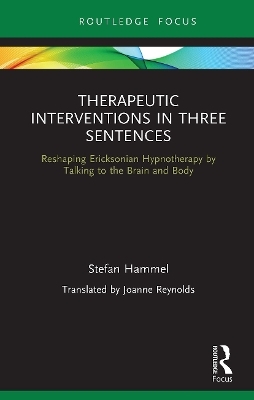
Therapeutic Interventions in Three Sentences
Routledge (Verlag)
978-1-032-57081-5 (ISBN)
Examining in detail the basic building blocks which must be in place in order for someone to send an effective command to his or her sub-conscious mind, the book presents an elegant way of using informal variations of Ericksonian hypnotherapy in awake states and transferring these principles to a variety of therapeutic settings. The methods described follow specific rules derived from hypnotherapy but can be integrated into any other form of counselling or therapy and can be used in short sessions, in telephone consultations and with patients in critical states, as well as conversations of a therapeutic nature by non-therapeutic professionals. The book explains why and how these interventions work, their general structure, and how they can be used to tackle specific needs such as trauma, depression, and anxiety disorders.
The book will be of great interest to counsellors, doctors and therapists of different orientations who are looking for therapeutic methods that can be used in short sessions or with patients in critical states, as well as non-therapeutic professionals who engage in conversations of a therapeutic nature, such as social workers, pastors, nurses, carers and teachers (including SEN teachers).
Stefan Hammel is a child and family therapist, hypnotherapist and a chaplain in a psychiatric hospital and a general hospital in Kaiserslautern, Germany. He leads seminars and workshops on therapeutic storytelling, hypnotherapy and systemic counselling around the world. For further information, please visit www.stefanhammel.com.
Introduction: Naaman, or: It cannot be that easy! I How to say "hello" to the mind Therapists instead of prophets? Setting the stage for greetings Greetings as ultra-short hypnosis The structure of greetings The language of greetings Separating problems, connecting solutions The use of metaphors and idioms The use of non-verbal language The sender of the greeting The bearer of the greeting The recipient of the greeting Identifying the response to greetings Testing the effect of greetings Using greetings on oneself When the mind greets you back II When to say “hello” to the mind Greetings to improve therapeutic effect Trauma Depression Bereavement Self-confidence, stage fright and exam nerves Compulsion, tics, stuttering Delusion and psychosis Sleep Food, addiction, habits Immune system Muscles Pain Hearing Other somatic issues Couples and family therapy Children's therapy References Appendix List of greetings Bibliography Index
| Erscheinungsdatum | 17.07.2023 |
|---|---|
| Verlagsort | London |
| Sprache | englisch |
| Maße | 138 x 216 mm |
| Gewicht | 149 g |
| Themenwelt | Geisteswissenschaften ► Psychologie ► Biopsychologie / Neurowissenschaften |
| Geisteswissenschaften ► Psychologie ► Humanistische Psychotherapien | |
| Medizin / Pharmazie ► Medizinische Fachgebiete ► Psychiatrie / Psychotherapie | |
| ISBN-10 | 1-032-57081-4 / 1032570814 |
| ISBN-13 | 978-1-032-57081-5 / 9781032570815 |
| Zustand | Neuware |
| Informationen gemäß Produktsicherheitsverordnung (GPSR) | |
| Haben Sie eine Frage zum Produkt? |
aus dem Bereich


